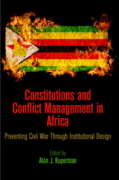Co-authored with Karly Kupferberg, this chapter was published in Constitutions and Conflict Management in Africa. It presents the findings of a research project conducted as part of the Constitutional Design and Conflict Management (CDCM) project, which was part of the Climate Change and African Political Stability project run by the Robert Strauss Center at the University of Texas at Austin.
We examine the impact of two shocks: first, the Sudanese government’s decision to make peace and share power with southern rebels in 2005, and subsequently the South’s vote for secession in January 2011. Both events fit the CDCM Project’s definition of “shock” as a sudden change in the balance of power and resources. These specific shocks are also useful to explore because they produced a variety of outcomes. There was no full-blown resumption of war between North and South, yet localized violence did erupt between the two sides, and within each side. In the North, fighting has occurred in the disputed Abyei area, as well as in Blue Nile and South Kordofan states. In the South, violence has broken out in Jonglei, Unity, Upper Nile, and Warrap states. In order to explain these different outcomes, the chapter examines to what extent the constitutional design of the CPA and the institutions that it created can be credited with constraining renewed North-South war and/or must be blamed for the violence that later broke out within the North and South.
Our analysis finds that the CPA’s constitutional design of institutions to regulate core North-South issues did successfully foster compromise in that realm, with assistance from international engagement. But the CPA did not similarly establish political institutions to regulate inter-group conflicts within each region, so violence did recur beyond the scope of core North-South issues. The one significant outbreak of North-South violence, in Abyei, was contained relatively quickly with international assistance because that dispute did not threaten the core interests of the South.
For the CDCM project as a whole, these findings highlight the role of two contextual factors — local leadership and international diplomacy — to help explain the success or failure of political institutions in mitigating the extent to which shocks produce violent consequences. In other words, institutions are important, but their effectiveness is conditioned by the behaviour of local and international leaders. Ostensibly perfect institutions may fail due to poor stewardship, while even imperfect ones can succeed at preventing violent escalation if local and international political leaders have sufficient political will.
The chapter proceeds in several steps. The next section provides a brief historical background to Sudan’s conflicts and their management. The following section contains the heart of the analysis. It traces the implementation process of the CPA from 2005, and establishes the reasons why — and the extent to which — the institutions and processes provided in the CPA were able to secure a relatively peaceful North-South separation, at least in the sense of avoiding renewed all-out North-South war. It also explores why the CPA failed to prevent localized violence — between North and South in Abyei, and within several states of the North and South. The conclusion summarizes the chapter’s findings, offers policy prescriptions, and suggests avenues for further — including comparative — research.

